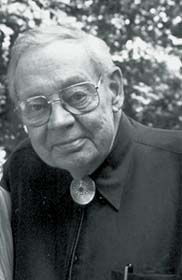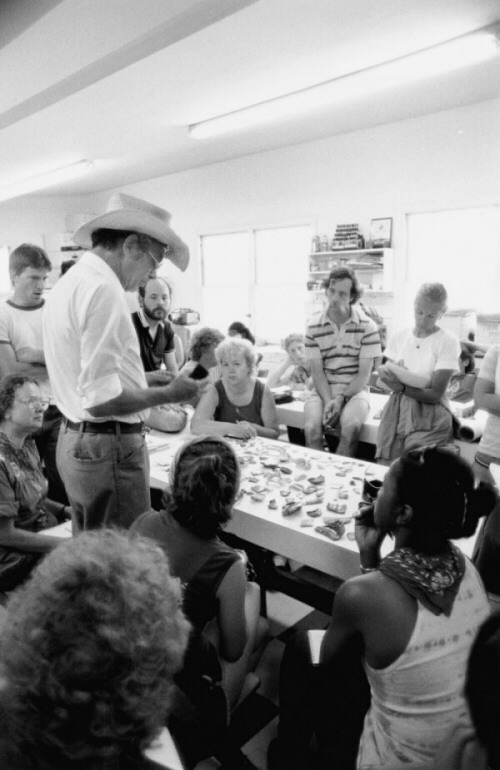James Fanto Deetz(1930-2000)By Kathryn Crabtree |  © Photograph by Coy Barefoot |
James Fanto Deetz(1930-2000)By Kathryn Crabtree |  © Photograph by Coy Barefoot |
| James Deetz was an outstanding anthropologist, a specialist in historical archaeology, whose professional career spanned forty years. Many students of cemeteries and gravemarkers are familiar with the pioneering work he and Edwin (Ted) Dethlefsen did in the 1960s, exploring the cultural patterns found in colonial gravestones from seventeenth- and eighteenth-century New England. As experimental archaeology, these studies are important in the history of archaeological theory. Deetz and Dethlefsen serendipitously discovered that they could use tightly controlled data from historic cemeteries to test some of the methods commonly applied to the study of prehistoric archaeological sites. Based on the notion that styles gradually come into fashion, reach a peak of popularity, and then decline in favor (which is shown graphically as the classic battleship-shaped curve), seriation allows an archaeologist to order sites chronologically before firm dates can be established. Deetz and Dethlefsen's results, happily, validated this relative dating method. They also found that the anthropological concept of diffusion, how cultural ideas spread, could be examined by distinguishing changes in gravestone styles. Further possibilities for interesting things to do with gravestones were seemingly endless, and exciting. One need only read Jim’s foreword to Richard Meyer's 1989 Cemeteries and Gravemarkers: Voices of American Culture to appreciate what a grand time it was! In some four years of studying colonial gravestones in New England (circa 1963-1967), Jim and Ted opened the doors for a new approach to material culture studies in archaeology -- by recording artifacts that were not only above-ground, but actually bearing dates, and furthermore, still in situ (their original place). Historical archaeologists have the advantage -- over those who study prehistory -- of access to documentary sources by which to check or support their interpretations of the data, and the information inherent in these early stones was prime material for learning more about the people who chose the designs and erected them as memorials. Jim and Ted also discovered Harriette Merrifield Forbes's seminal study, and they applied what she had learned about the carvers of these folk objects to the task at hand.1 Paying close attention to stylistic variations in the artifacts, combined with archival research and knowledge of the historic period under study, Jim and Ted sought the underlying reasons for such changes. The sequence they perceived, from death's head to cherub to urn and willow, appeared to be resonant with documented changes in religious views prevalent over the period under study. The two scholars co-authored five professional papers from their cemetery findings, which are listed in the Appendix. The clearest statement of this work for the non-archaeologist is "Death's Head, Cherub, Urn and Willow," originally published in Natural History magazine in 1967. Its lasting value is evident from the three reprints of this article that have appeared, one in a collection of general interest and two in readers intended for classroom use.2 While Ted's later work would include a number of studies specific to gravemarkers, Jim cast his net in various directions. But he never forgot the lessons he had learned from looking at colonial stones early in his career, and he continued to use gravemarkers as examples in teaching and in nearly every paper and book he wrote for the next thirty-plus years. He probably sent hundreds of students from his always-popular courses in American material culture out to their local graveyards for term paper and thesis projects, demonstrating that it is entirely possible to do archaeology without ever setting a spade in the dirt. As he once told Kathryn, in an advisor-student meeting, a gravemarker is "the most violent communicative device going!" Jim was born in Cumberland, Maryland, and earned his undergraduate and graduate degrees at Harvard. His 1960 doctoral dissertation on Arikara ceramics was published in 1965, and is still considered an important contribution, while his 1967 Invitation to Archaeology remains an excellent introduction to the field (in fact, it was translated into Japanese as recently as 1988). Although initially trained in prehistoric archaeology, Jim's ever-expanding intellectual curiosity led to anthropological studies of early American life, first in New England, and later in Tidewater Virginia. Eventually his research became truly global, as he applied his knowledge of American and British material culture to comparative studies of English settlements in colonial-period South Africa. His academic appointments included the University of California at Santa Barbara, Brown University, and the University of California at Berkeley (where he also served as the director of the then-Lowie Museum of Anthropology, and won Berkeley's Distinguished Teaching Award in 1982). From 1994 he held an endowed chair, Harrison Professor of Historical Archaeology, at the University of Virginia. He wrote six books, edited others, and prepared a large number of journal papers over the course of his career. Here we have chosen to highlight only a few of his many publications -- those of particular interest in gravestone studies, some other significant theoretical works, and his major books. Among the latter is Jim's multiple award-winning study, Flowerdew Hundred: The Archaeology of a Virginia Plantation, 1619-1864, which was published in 1993. His full, and extensive, bibliography (and additional information about him) may be viewed on-line at The Plymouth Colony Archive Project.3 It is worth noting, also, that his students presented him with two festschrifts during his lifetime.4 Jim was one of the first to embrace, and indeed helped define, the specialty known as historical archaeology in this country, which is now recognized as a specific sub-discipline of anthropology. He was one of the earliest presidents of the Society for Historical Archaeology (in 1974), and its membership would recognize his life-long contributions to the field with the J.C. Harrington Medal in Historical Archaeology in 1997, thirty years after the organization was founded.5 For his innovative contributions to Plimoth Plantation (where Jim was Assistant Director from 1967 to 1978, and later a trustee), he was honored with the Henry Hornblower Tribute Award in 1999. And, of course, most readers of this journal will be aware that he, along with folklorist Warren Roberts, jointly received the Harriette Merrifield Forbes Award from the Association for Gravestone Studies in 2000. Jim was a scholar of great depth and breadth, and he was a supremely gifted teacher, both in the classroom and outside of it. All of us who had the privilege of studying under him or working with him in a variety of settings will always remember his irrepressible nature, his entertaining (often irreverent, but always insightful) lectures and comments, and his joie de vivre. Numerous crew members who lived in tents through steamy, stormy, Virginia summers would have to admit that Jim could make all manner of discomforts not only bearable, but fun. He certainly took a broad view of his work, as he commented to Gene in the field on the Flowerdew project: "one minute I'm doing archaeology, and the next minute I'm doing folklore; half an hour ago I was doing history." But eventually it all came together. Jim's goals, clearly, were not frivolous: he made his students and his colleagues think, think about the reasons for the work -- and the methods we bring to it -- and always to reach for the big picture. What was life really like for the people whose discarded garbage we excavate and whose houses we measure, and how did their beliefs affect the artifacts they made and used? Among his research specialties he listed "the greater understanding of culture, cognition, and the impact of mind on the shape, form, and use of the material world."6 The finest guide to his way of thinking that we can recommend is Jim's 1996 book, In Small Things Forgotten: An Archaeology of Early American Life (revised and expanded from the edition published in 1977). It is scholarly, yet a very accessible work, for he always wrote clearly and concisely, to communicate his ideas not just to other academics, but to as wide an audience as possible. This brief study both explains the value of doing historical archaeology and treats a range of material culture as clues, not only to behavior, but also to a worldview (to us, quite foreign) of people who lived in the past. Anthropologists use the concept of culture, which, Jim would have us remember, is itself a mental construct, to understand human behavior in all of its complexity. His work frequently focused on how cultures change over time, and he was a master of discovering stylistic variations that point to the underlying patterns. The changes seen in gravestones -- to which he devotes a full chapter in this book -- are correlated with other classes of material culture (ceramics, houses, foodways, music, etc.) that mutually support his thesis. What Jim wanted us to understand was that the "small things" left by those who came before us are their legacy; and if we are careful in our analysis and courageous in our interpretations, the objects provide one of the most honest statements from which to seek knowledge of the past. Jim's body of work teaches archaeologists, and many others, to view gravemarkers and cemeteries as cultural artifacts and landscapes of deep significance to those who made and used them. The inclusion of the cemetery has become standard practice in community studies, for this allows the investigator access to an invaluable set of artifacts of both social and religious importance. Jim's gift was to broaden our perspectives, to open our eyes to differing historical uses of commonplace objects, and to insist that we think hard about their meaning (or their multiple meanings, depending on the cultural context in which they were used). For only then can we begin to incorporate more of the people who lived in the past: not just the famous, the wealthy, and the literate, but the majority, who indeed left few, if any, written records. By using a combination of solid scholarship within a sound historical framework and careful analysis of the artifactual record, the stories we tell about the past will make meaningful connections with the lives of the people who lived there, which can only be a good thing for all concerned.  James Deetz teaching a ceramics class, |
| A memorial fund has been established in Jim's honor to further promote the efforts of the Plimoth Plantation Living History Museum. Donations may be sent to: Plimoth Plantation P.O. Box 1620 Plymouth, MA USA 02362 |